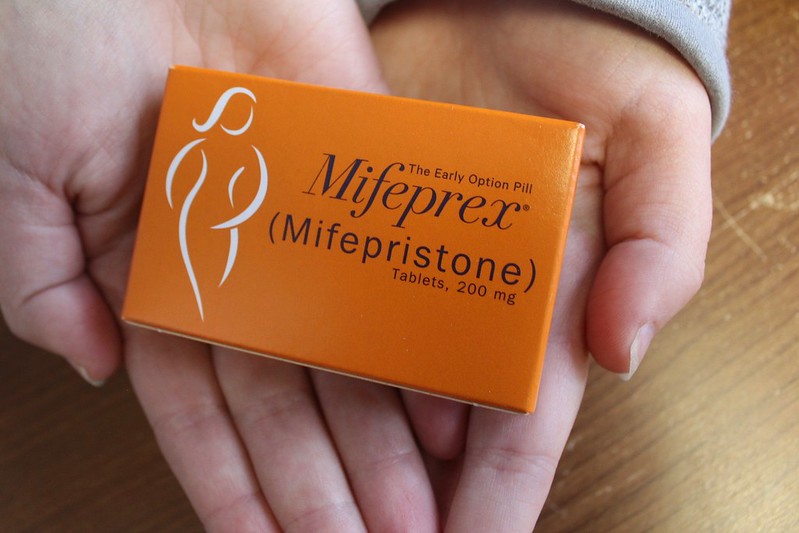
What if you could pick up your abortion medications at a local pharmacy, order them to be shipped to your front door, or purchase them in a drug store or grocery without a prescription, like a pregnancy test or emergency contraception?
We are one step closer to expanding access to medication abortion in all these ways, now that the Food and Drug Administration (FDA) has recommended the permanent removal of its in-person dispensing requirement for mifepristone. For years, advocates, clinicians and researchers have proposed the use of alternative models for dispensing mifepristone and misoprostol, the pills used in a medication abortion. Yet, implementation remained thwarted by outdated and medically unnecessary regulation of mifepristone.
Many abortions—roughly 40 percent in the U.S.—are completed with pills alone. The FDA approves use of mifepristone and misoprostol up to 10 weeks’ gestation.
When the FDA first approved mifepristone in the year 2000, an extra layer of regulatory scrutiny was applied that limited where it could be provided and by whom. Of thousands of FDA-approved medications, fewer than 100 have what is referred to as a Risk Evaluation and Mitigation Strategy (REMS), which aims to ensure the benefits outweigh the risks.
Up until Thursday, the mifepristone REMS consisted of three components:
- providers must complete a self-certification process with the drug’s distributor to provide mifepristone;
- patients must sign a special patient-agreement form; and
- the pills must be dispensed in a clinic, medical office or hospital.
The FDA announced Thursday it has permanently removed the third requirement and will allow certified pharmacies to dispense the pills.
The COVID-19 pandemic intensified debates about whether the in-person dispensing requirement was necessary. Due to the health emergency, the FDA suspended its in-person dispensing requirement and allowed mail-order pharmacies to ship prescribed pills directly to patients after in-person or telehealth assessments. Demand for online abortion providers of abortion medications, like Choix and Hey Jane, dramatically increased. In April 2021, the FDA then announced that it would review the evidence to inform its policy after the emergency ends.
The removal of mifepristone’s in-person dispensing requirement enables continued use and further expansion of online telehealth services and dispensing from pharmacies. Offering a variety of dispensing options would better meet the needs of patients with differing priorities. Telehealth may appeal to those who value provider interaction but want to avoid protestors at clinics. People who live far from an abortion clinic might opt to have a telehealth visit and pick up the pills at a local pharmacy or have them sent from a mail-order pharmacy. The involvement of pharmacy dispensing could enable primary care and family medicine clinicians, who may not be able to easily stock or dispense mifepristone in clinic, to offer abortion care.

A large body of evidence has shown that the mifepristone REMS is medically unnecessary and imposes a barrier to access. For many, it is burdensome or even impossible to find the time, resources, and childcare necessary to make an appointment, travel to a clinic, and take the medications before they reach the gestational age limit for medication abortion. Studies show that alternative dispensing models are feasible, safe, effective, and acceptable to patients. Providers can effectively assess patients for clinical eligibility without physical contact and prescribe and dispense abortion medications virtually.
While the FDA decision is good news, it does not go far enough yet to align with the evidence. Requiring that pharmacists obtain a special certification to dispense mifepristone is unnecessary with respect to safety and effectiveness and will only serve to deter pharmacists. Given recent breakdowns in the postal service, obtaining the pills at a community pharmacy would be the timeliest way to access medication abortion for some people. It is also unclear why the FDA is retaining the provider certification and patient agreement elements of the REMS, neither of which improve medication abortion safety.
In addition, the FDA’s decision to remove the mifepristone in-person dispensing requirement will not guarantee full access for all. Not everyone is eligible for medication abortion in the first place, and not everyone would choose it over procedural abortion if they were. Current bans on telemedicine use for abortion exist in 19 states, where access is most constrained.
Still, the removal of the in-person dispensing requirement for mifepristone is an essential first step that will improve access to medication abortion for many people by enabling a broader spectrum of safe and effective models of care. Just how big an impact this policy change will have on improving equitable access to abortion care remains to be seen, and we look forward to conducting research on these new models of care as they expand.
Up next:





